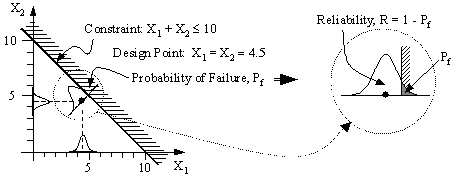Overview of Reliability Analysis Methods | ||
| ||
The concepts of reliability and probability of failure are shown in the following figure:

For the example shown above the current design point, given as , is within the specified constraint of therefore, this design appears to be feasible. If both and are known to vary around their nominal values (roughly between values of 3 and 6 in the figure above), the performance measure will also vary. In this case a portion of the expected distribution of lies outside the constraint. The area of this distribution that is outside the constraint defines the probability of failure associated with this design point and the defined constraint. The area of the distribution that lies within the constraint (in the feasible region) is defined as the reliability level of this design.
Many methods for determining the probability of failure or reliability (estimating the areas inside and outside the constraints) have been developed in recent years. These methods are used to evaluate reliability of the current design point.